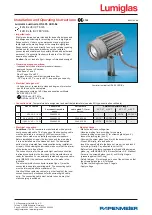
• Important note:
Sight glass luminaires are intended for a specific purpose and
are designed exclusively for mounting on or onto sight glass
flange sockets. Under no circumstances may a sight glass
lamp replace the mating flange or the complete sight glass
flange socket or be used directly to cover a container opening.
Luminaires for hazardous areas may only be installed,
connected and maintained by specially trained and authorised
personnel. It is essential to observe the data of the EU type-
examination certificate!
Caution:
Do not look into light – danger of impaired eyesight!
• General operating conditions:
- Independent of vessel internal pressure/vacuum –
approved for use in Ex areas:
Gas: Zones 1 and 2
Dust: Zones 21 and 22
- Approved for use in ambient temperatures from
-20°C up to +60°C or up to +50°C, depending on capacity
• Electrical data, general:
- Voltage, power, temperature class and degree of protection
can be found on the nameplate.
- Ex approval according to EU type examination certificate:
BVS 08 ATEX E 133
II 2G Ex db IIC T6 Gb
II 2D Ex tb IIIC T80°C Db
Lumistar luminaire USL 05 LED-Ex
Lumistar Luminaire USL 05 LED-Ex
II 2G Ex db IIC T6 Gb
II 2D Ex tb IIIC T80°C Db
F.H.Papenmeier GmbH & Co. KG
Talweg 2, 58239 Schwerte, Germany
Phone: +49 2304 205 0 • Fax: +49 2304 205 206
info@lumiglas.de • www.lumiglas.de
Installation and Operating Instructions
0158
0093.146.00
• Connection data:
Temperature data assignment and electrical parameters (see also EU type-examination certificate)
Item
USL 05 LED-Ex
Variant with
2 m connection cable
part no.
Variant with
cable gland 7-11 mm
part no.
Ambient temperature range
-20°C ≤ T
a
≤ +50°C -20°C ≤ T
a
≤ +60°C
1
230 V AC – 4 W
3540.059.00
–
–
–
2G T6
2D T80°C
2
24 V AC/DC – 7.5 W
3540.042.00
3540.935.00
2G T6
2D T80°C
–
–
3
110-230 V AC – 7.5 W
3540.043.00
3540.936.00
2G T6
2D T80°C
–
–
• Electrical connection:
Conditions:
The Ex luminaire is manufactured with a perma-
nently connected cable. The free ends of the connecting cable
must be installed in a category 2G/2D enclosure if the
connection is made in a potentially explosive atmosphere.
Before installation or repair, the luminaire and the area where
it is to be installed must be cleaned of dust. The dismantled
parts must be protected from contamination during installation
or repair. When closing the luminaire, make sure that the interior
of the luminaire is free of dust.
The connection line for the pressure-tight cast connection line
is already connected in the luminaire by the manufacturer and
ready for operation. For an externally tested and approved cable
entry (M20x1.5), the cable connection must be made in the
luminaire.
The external protective conductor terminal (pos. 1) must be
connected to separate operating earth. The connecting cable
must be intercepted after a maximum of 1 m.
Attention! When replacing cables (e.g. other lengths), the inner
connections must be loosened before unscrewing the cable
entry. The connecting cable must be laid in such a way that
static charging is excluded.
• Module change:
- Make the luminaire voltage-free
- Observe waiting time according to type plate
- Loosen locking screw (pos. 2) for screwed glass (pos. 4);
loosen the locking tab (pos. 3)
- Unscrew the screw glass (pos. 4) with the assembly key
- Press LED briefly, turn and pull out
- Insert the spare bulb into the bayonet, press it on and lock it
by turning it briefly. Pay attention to correct fit!
- Before closing the lamp, regrease the thread of the screw-on
glass (e.g. with AEMA-SOL 6 B, manufacturer A. E. Matthes)
- Screw in the screwed glass (pos. 4) until it is tight again
(pressure against the O-ring)
- Safety tab (pos. 3) must engage in one of the notches so that
the screwed glass (pos. 4) is locked
- Tighten the locking screw (pos. 2) again
- Apply voltage



















